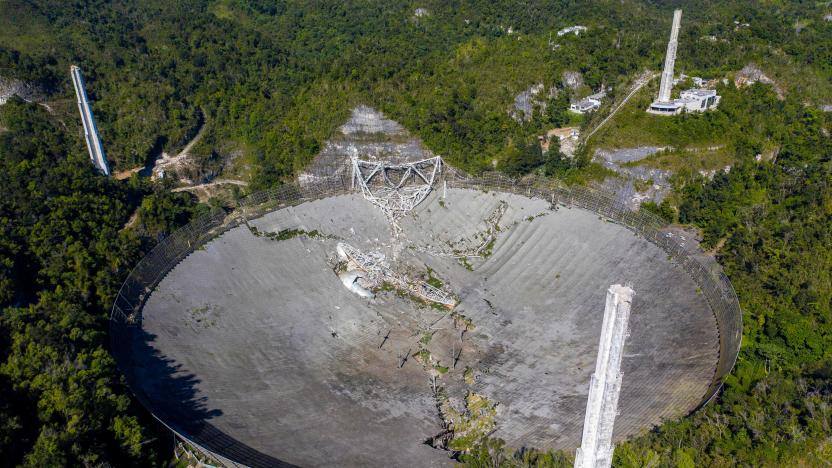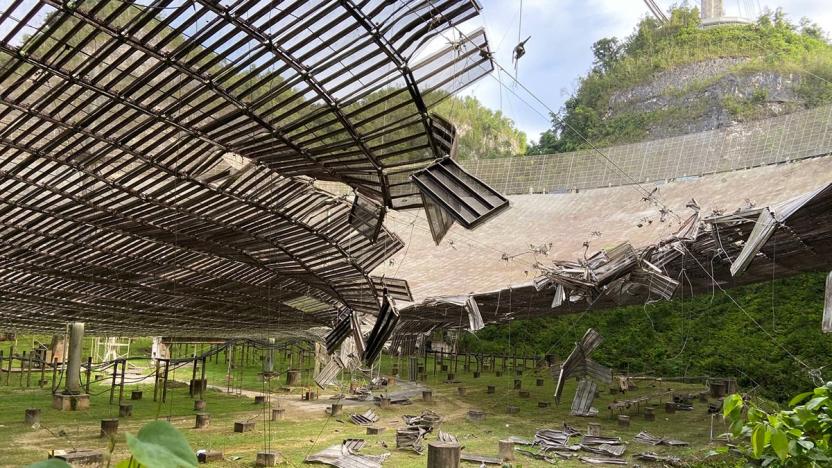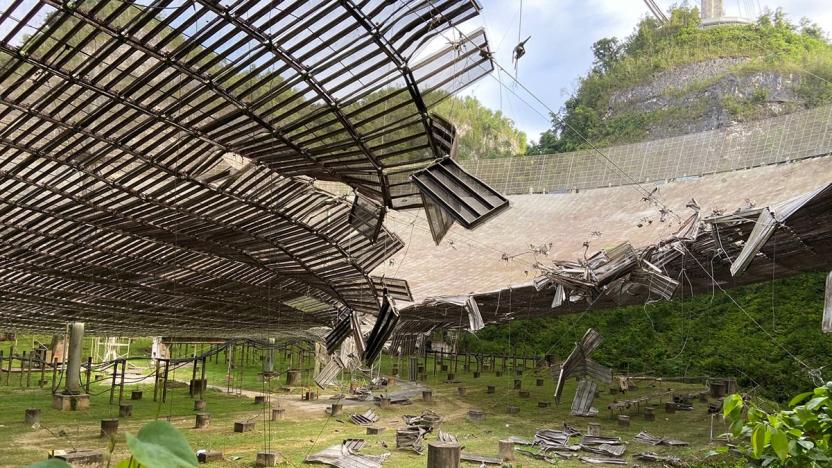National Science Foundation
Latest

Arizona wildfire may spare Kitt Peak National Observatory's telescopes
The ongoing Contreras Fire in Arizona has seemingly spared the Kitt Peak National Observatory from a worst-case scenario.

Senate bill would add friction to social media posting
The Social Media NUDGE Act takes aim at 'the harm of algorithmic amplification and social media addiction.'

PAWS anti-poaching AI predicts where illegal hunters will show up next
AI and machine learning systems are poised to drastically improve wildlife rangers’ effectiveness by helping them not only track where poachers have been but also predict where they are most likely to turn up.

Puerto Rico commits $8 million to rebuild Arecibo telescope
Puerto Rico has approved $8 million to help rebuild the Arecibo Observatory telescope, although it will likely need considerably more help.

The Arecibo Observatory's telescope has collapsed
The world-famous Arecibo Observatory has collapsed.

Arecibo Observatory will be torn down because repairs are too dangerous
After 57 years of helping to expand human knowledge and understanding of the cosmos, the story of Puerto Rico’s world-famous Arecibo Observatory is coming to an unfortunate end.

Puerto Rico’s Arecibo radio telescope suffers serious damage
A broken cable damaged the Arecibo Observatory, the second-largest radio telescope in the world.

Scientists want to fix our notoriously insecure smart home devices
The dream of a smart home that would automate your life like The Jetsons is more like a nightmare thanks to the lack of security in numerous smart devices. Now, the National Science Foundation (NSF) is intervening with a nationwide project designed to boost internet of things (IoT) security.

Capturing the Sun's Texas-sized cells in the highest detail ever
The Daniel K. Inouye Solar Telescope (DKIST) started with some controversy, but its first images are already changing the field of solar science. The Maui observatory captured the highest-resolution photos of the sun ever taken, revealing detail down to a mere 18 miles in size. The image above shows turbulent kernel-like cells made up of boiling gases influenced by the Sun's strong magnetic field, each one about the size of Texas.

Arecibo Observatory nets $19 million grant to search for dangerous asteroids
NASA has ensured the Arecibo Observatory in Puerto Rico can continue its search for near Earth objects (NEOs) that pose a threat to the planet with a $19 million grant. The fund was awarded to the University of Central Florida, which operates the observatory on behalf of the National Science Foundation.

Alt-week 9.15.12: The ultimate wind machine, Egyptian Lego and the office of our dreams
Alt-week peels back the covers on some of the more curious sci-tech stories from the last seven days. Sometimes we wonder, what would we have ended up doing if we didn't spend our time trawling the web for the week's best alternative tech stories? We could have been paleontologists, novelists, engineers, or if we were really lucky, worked for Google. Instead, here we are bringing you some of the more colorful tech-tales from the last seven days, which we're really not complaining about. That said though, at least on this occasion, we got to taste a bit of all the above. This is alt-week.

Researchers propose à la carte internet services, overhaul for web infrastructure
A quintet of researchers funded by the National Science Foundation have envisioned a new internet architecture, one where features could be purchased à la carte. The proposed framework would allow users to fine tune their experience by choosing from a variety of connection services. Let's say, for example, that a customer's connection is fine for browsing the web, but it doesn't pass muster for streaming content -- a service dedicated to video delivery could be added to close the gap. "Ultimately, this should make the internet more flexible and efficient, and will drive innovation among service providers to cater to user needs," report co-author Rudra Dutta told The Abstract. A piecemeal next-gen web is no easy feat, however, as it would require revamping the web's infrastructure with new protocols for choosing particular features, completing payments and monitoring network performance. The group's rough blueprint will be presented at a conference next week, but you can thumb through their short paper at the source.

10 Gigabit per-second connection between US and China demoed
You, sir or ma'am, should probably not get too excited. Chances are, this trans-Pacific 10 Gigabit link won't do you any good, personally. On the other hand, researchers working together across the oceanic divide have tons to cheer about. The China Education and Research Network, the National Science Foundation and Indiana University worked together with BGI, one of the largest genomics organizations in the world, to christen the connection by transferring 24 Gigabytes of genomic data from Beijing to UC Davis in under 30 seconds. As a benchmark, the same file was sent between the same locations over the regular ol' Internet and it took over 26 hours. The high-speed link should prove to be a major boon for genetic research and DNA sequencing.

White House aims to make internet '90 percent cheaper' to build, teams up with Mozilla for $500k competition
The government's US Ignite partnership aims to push the growth of next-generation broadband networks, teaming up with over 100 start-ups, universities and existing tech companies like HP, Comcast and Verizon for the project. The President is set to sign an executive order today that aims to cut the cost of broadband construction across federal roadways and properties by up to 90 percent. The White House is also is looking to improve "next-generation applications and (the) digital experience," running on networks that are a heady 100 times faster than what's in use today. The National Science Foundation has thrown in $250 million to assist the partnership's creation of a national 1-gigabit network that would connect together academic and developer hubs. Mozilla has decided to team up with the foundation to offer up a $500,000 prize pot for developers looking to help create the "internet of the future". The challenge aims on education, healthcare, public safety and other (admittedly broad) topics, with the top ideas capable of grabbing $15,000 from the prize fund. And if Google reckons gigabit networks are the way to go, who's the White House to argue?

Supercomputer gets a memory boost with 380 petabytes of magnetic tape
Remember the Cray XK6 at the University of Illinois that drives the National Science Foundation's Blue Waters project? Well, it looks like it's getting a little memory upgrade, sorta. We're not talking a slick new SSD here, or even a sweet NAS, all that computational power requires nothing less than... tape. Okay, so it's actually a full storage infrastructure, and some of it -- 25 petabytes no less -- will be disk-based. The rest -- a not insignificant 380 petabytes -- will be the good old magnetic stuff. The idea is that the disk part will be used for instant access, with the tape section serving as "nearline" storage -- something between an archive and online solution. Spectra Logic is providing the tape, and says it'll take a couple of years to implement the whole lot. Once complete, the system will support the supercomputer's lofty tasks, such as understanding how the cosmos evolved after the Big Bang and, y'know designing new materials at the atomic level. And we thought we were excited about out next desktop.

VT nears completion of HokieSpeed, world's 96th most powerful supercomputer
If basking in the presence of a powerful supercomputer is on your list of "must-haves" when selecting a proper university, then you may wish to fire off an admissions application to the Hokies at Virginia Tech. The school's HokieSpeed system is now in its final stages of testing, which combines 209 separate computers, each powered by dual six-core Xeon E5645 CPUs and two NVIDIA M2050 / C2050 448-core GPUs, with a single-precision peak processing capability of 455 teraflops. To put things in perspective, HokieSpeed is now the 96th most powerful computer in the world, and yet it was built for merely $1.4 million in loose change -- the majority of which came from a National Science Foundation grant. As a further claim to fame, HokieSpeed is the 11th most energy-efficient supercomputer in the world. Coming soon, the system will drive a 14-foot wide by four-foot tall visualization wall, which is to consist of eight 46-inch Samsung 3D televisions humming in unison. After all, with virtually limitless potential, these scientists will need a fitting backdrop for all those Skyrim sessions. The full PR follows the break, complete with commentary from the system's mastermind, Professor Wu Feng.

University gets $188 million AMD-based supercomputer, free copy of Norton
It used to be that you only needed a bachelor's degree and elbow patches to be taken seriously as an academic, but now it's all about that 50-petaflop supercomputer with 500 petabytes of storage whirring away in the basement. The University of Illinois used to shop with IBM, but it's just about to have a brand new Cray XK6 installed instead, so it can continue providing computing power to the National Science Foundation's Blue Waters project. It's not all about inciting gadget envy, of course: the machine's unlikely truce of AMD Opteron 6200 16-core processors and NVIDIA Tesla GPUs will help more than 25 teams of scientists to model and understand real-world phenomena, from the damage caused by earthquakes to the way viruses to break into cells. Breakthroughs from these projects will -- hopefully, one day -- make the $188 million total cost of Cray's products and services seem like a bargain. Full details in the PR after the break.

USC computer scientist makes geo-immersion maps, leaves other maps feeling inferior
Google's Maps and Earth services provide us with 3D maps, the means to track St. Nick, and even tools to help us train to wear the maillot jaune. Real-time views of the world are not among Street View's many powers, however. That's why the director of USC's Integrated Media Systems Center, Cyrus Shahabi, has one-upped El Goog by rendering the real world virtually using the concept of geo-immersion -- which integrates real-time information and videos with digital maps. In one application, users can see the energy usage and floor plans of university buildings along with the current location of campus transit buses. Another uses live video feeds from security cameras and facial recognition technology to track ne'er-do-wells in a three dimensional model of a city. Itching to see what happens when real and virtual worlds collide? Check out the cutting-edge cartography in action after the break.

Dell to trial mushroom-based packaging on servers, hugs IT hippies
We've already seen Dell embracing the bamboo woods to package its products, so what's next for Round Rock's green fingers? Mushrooms, apparently. Unveiled at the Fortune Brainstorm Green conference yesterday is a biodegradable cushioning tray, which is grown -- yes, grown -- out of a mold stuffed with old cotton hulls, mushroom spawn, and nutritious agricultural waste. While it does take about five to ten days for the mycelium (aka mushroom root) to form the desired shape, the merit of such process is that all the energy required for the manufacture is provided by the recycled waste, thus reducing other energy dependencies. What's more, this fungal packaging has already passed Dell's extensive lab tests "like a champ," and it'll soon be trialed on Multipack packaging shipments for the PowerEdge R710 servers. If you want to thank Michael, he'll be in his usual tree house.

Scientists discover planet capable of supporting life, Richard Branson calls dibs on it
A team of planet hunters from UC Santa Cruz (not to be confused with Dog The Bounty Hunter) have found a planet three times the size of our own that might support life. Scientists have been using the HIRES spectrometer on the Keck I Telescope to keep an eye on the Gliese 581 red dwarf star in the constellation Libra for about 11 years now, and among its many virtues have learned that the planet Gliese 581g has the potential for life. Indeed, it is being billed as "the first potentially habitable exoplanet," meaning that it's in "the zone" where it's neither too hot nor too cold for liquid water. Although it's rather Earth-like in some respects, there are some stunning differences: for instance, the planet doesn't spin on its axis, so one side is always dark (and probably 25 degrees below zero) while the other side is probably rather pleasant, or "shirt-sleeve weather," as one of the discoverers, Steven Vogt, put it. Indeed, he goes on to estimate that "chances for life on this planet are 100 percent." Those are pretty good odds! There's no word on when Virgin Galactic will be offering vacation packages to this hit destination, or even when it will be feasible to make the 20 light year voyage. Artist's rendition after the break.














